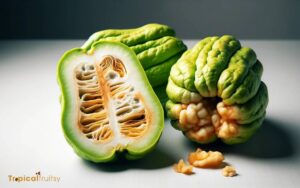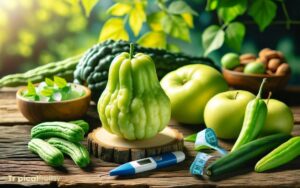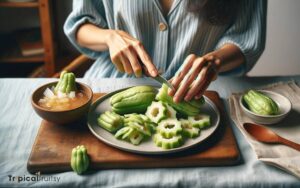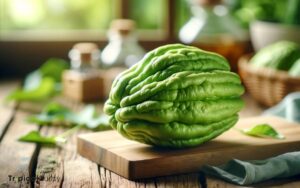How to Make Chayote Juice? 9 Easy Steps!
Chayote juice is a refreshing and nutritious beverage made from chayote squash. To make chayote juice, wash and slice one chayote, remove the seed, and blend it with a cup of water until smooth.
Strain the mixture, add lemon and honey to taste, and serve chilled or over ice for a healthful drink.
Chayote, also known as vegetable pear or mirliton, is a mild-flavored squash that is rich in vitamins and minerals. Its juice is not only hydrating but also offers potential health benefits, such as supporting weight loss and reducing inflammation.
Here’s a step-by-step guide to making chayote juice:
For added nutritional benefits and flavor, you can also include other ingredients such as ginger, apple, or mint in your juice blend.
Try chayote juice for a unique twist on your daily hydration; it’s simple to make and brimming with healthful properties that can enhance your overall wellness.
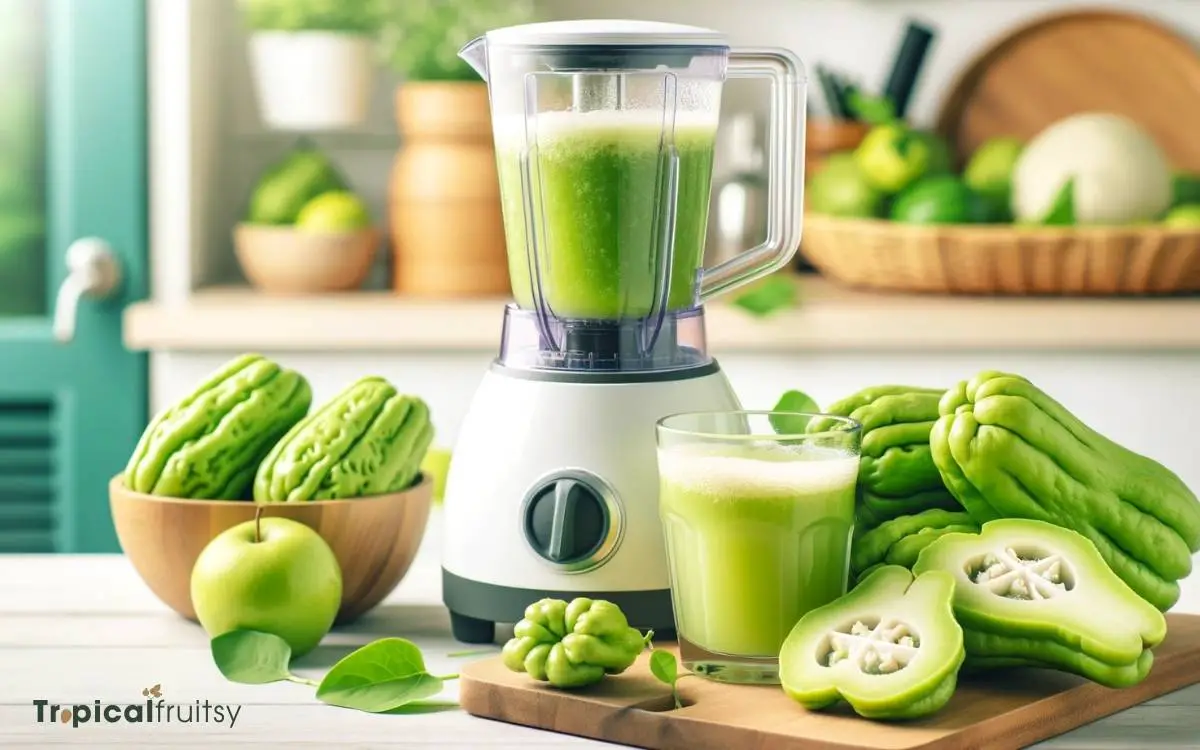
Key Takeaway
Step 1: Selecting the Perfect Chayote
Why should one prioritize choosing firm, unblemished chayotes when intending to craft a refreshing glass of chayote juice? The quality of the chayote significantly influences the nutritional value and taste of the juice.
Firm chayotes are typically fresher and contain higher levels of vitamins and minerals essential for maintaining good health.
These include vitamin C, which is pivotal for immune system function, and dietary fiber, which supports digestive health.
Unblemished chayotes are likely free from decay and contaminants that could compromise the juice’s flavor and safety.
To maximize the health benefits and ensure a pleasurable drinking experience, selecting the best chayotes is crucial.
Having chosen the ideal chayote, we must now consider the essential tools and equipment necessary for juicing.
Step 2: Essential Tools and Equipment
Having selected quality chayotes, the next step is to gather the appropriate tools and equipment for juicing, including a sturdy juicer or blender, a sharp knife, and a fine-mesh strainer.
These items are crucial to extract the juice efficiently while preserving its nutritional content.
| Equipment | Purpose | Importance |
|---|---|---|
| Juicer/Blender | To pulverize the chayote into a liquid form | Essential for juicing |
| Sharp Knife | For peeling and cutting the chayote | Ensures clean cuts |
| Fine-Mesh Strainer | To separate the juice from the pulp | Provides smooth texture |
Selecting the right tools can make a significant difference in the juicing process, potentially impacting the juice’s quality and the retention of vital nutrients.
As we move forward, remember that the preparation of chayote is just as important as the juicing itself.
Step 3: Preparing the Chayote
Preparation is the cornerstone of creating a flavorful and nutritious chayote juice. To begin, select firm, unblemished chayotes as they are likely to be rich in essential nutrients such as vitamin C, folate, and fiber.
Wash the chayote thoroughly under cold running water to remove any dirt or potential contaminants, ensuring that the juice will be safe for consumption.
Peeling the chayote is optional, as the skin is edible and contains valuable fiber, but peeling may be preferred for a milder taste in the juice. Once peeled, cut the chayote in half and remove the seed, which can impart a bitter flavor.
Chop the chayote into smaller pieces that will easily blend, maximizing the extraction of vitamins and minerals during the juicing process.
Step 4: Sweetening Options
You may choose to enhance your chayote juice with natural sweeteners, as the vegetable’s mild flavor pairs well with a variety of sweetening agents.
When selecting a sweetener, consider its nutritional profile and how it complements your health goals.
Here are some options:
- Raw Honey: A natural sweetener with antioxidants and antibacterial properties.
- Agave Syrup: Lower on the glycemic index, suitable for those monitoring blood sugar.
- Maple Syrup: Contains minerals like zinc and manganese, and provides a unique flavor.
- Stevia: A calorie-free option that is much sweeter than sugar, requiring minimal amounts.
- Dates: High in fiber and nutrients, they can be blended into the juice to add natural sweetness.
Choose a sweetener that aligns with your dietary preferences and enhances the nutritional value of your chayote juice.
Step 5: Juicing Methods
Several methods are available for extracting juice from chayote, each offering distinct advantages depending on your equipment and preferences.
Traditional centrifugal juicers can quickly process chayote, but they may introduce heat and oxidation, potentially reducing some nutrients.
Masticating juicers, on the other hand, operate at lower speeds, minimizing heat and preserving the chayote’s enzymes and vitamins.
For those without specialized juicers, blending the chayote with a little water and straining the mixture through a fine mesh can also yield nutrient-rich juice.
Regardless of the method, it’s important to use fresh chayote to ensure the highest nutritional content, as the vegetable’s beneficial antioxidants and vitamins like C and B-complex can degrade over time.
Choose the method that best aligns with your nutritional goals and kitchen tools.
Step 6: Straining Your Juice
After blending the chayote with water, it is essential to strain the mixture through a fine mesh sieve to separate the pulp from the liquid, ensuring a smooth juice.
Straining not only improves the texture and drinkability but also helps in better absorption of the nutrients present in chayote, as it removes excess fiber that could otherwise slow digestion.
- Use a fine mesh sieve to catch all the solid bits for a clear juice.
- Apply gentle pressure to extract maximum liquid while preserving nutrients.
- Discard the pulp, or repurpose it in compost or other recipes to minimize waste.
- Rinse the sieve promptly to prevent sticking and preserve the equipment.
- Chill the strained juice before serving to enhance its refreshing quality.
Understanding the importance of a smooth texture in juicing leads us to considering flavor enhancements for an optimal juicing experience.
Step 7: Flavor Enhancements
Frequently, adding natural sweeteners or citrus notes can significantly elevate the taste profile of chayote juice. When selecting flavor enhancements, consider their health benefits and compatibility with the mild taste of chayote.
For instance, raw honey, not only sweetens the juice but also introduces antioxidants and enzymes beneficial for digestion.
Similarly, the addition of lemon or lime juice contributes vitamin C, aiding in immune system support and iron absorption.
Here is a table providing options for flavor enhancements:
| Enhancement Type | Health Benefit |
|---|---|
| Raw Honey | Antioxidants, Digestive Enzymes |
| Lemon Juice | Vitamin C, Immune Support |
| Fresh Ginger | Anti-inflammatory, Digestive Aid |
| Mint Leaves | Digestive Support, Freshness |
These natural additives enrich the juice while providing additional nutritional value and should be used judiciously to tailor the flavor to your liking.
Step 8: Nutritional Benefits
The introduction of natural flavor enhancements not only augments the palatability of chayote juice but also complements its impressive nutritional profile, which includes a variety of vitamins, minerals, and fiber.
Chayote, being low in calories yet dense in nutrients, is a stellar choice for individuals aiming to maintain or improve their health.
Here are some of the key nutritional benefits:
- Vitamin C: Supports immune function and skin health.
- Fiber: Aids in digestion and helps maintain healthy blood sugar levels.
- Vitamin B6: Essential for metabolism and brain health.
- Magnesium: Important for muscle and nerve function, and bone health.
- Potassium: Helps regulate blood pressure and is crucial for heart health.
These components make chayote juice a nourishing beverage that can contribute to a balanced diet.
Step 9: Serving and Storage Tips
While freshly prepared chayote juice offers the best flavor and nutritional value, proper storage is essential to maintain its quality over time.
To maximize the beverage’s benefits, consume it immediately after juicing, when the enzyme activity is at its peak.
If storage is necessary, pour the juice into a clean, airtight glass container to minimize oxidation and nutrient degradation. Refrigerate promptly and consume within 24 hours for optimal freshness.
Avoid plastic containers as they can leach chemicals into the juice and affect its flavor and safety.
For extended storage, freezing the juice in an airtight container is an option, though some nutrient loss may occur. Thaw the juice in the refrigerator when ready to consume, and stir well before serving.
Conclusion
Chayote juice offers a unique blend of flavor and nutritional benefits. One particularly compelling statistic is that a single chayote contains 189 mg of potassium, which is about 4% of the daily recommended intake, contributing to cardiovascular health.
By following the outlined steps to create this juice, consumers benefit from a hydrating beverage enriched with vitamins and minerals.
Proper preparation and storage enhance the juice’s quality, ensuring a healthful addition to any diet.

